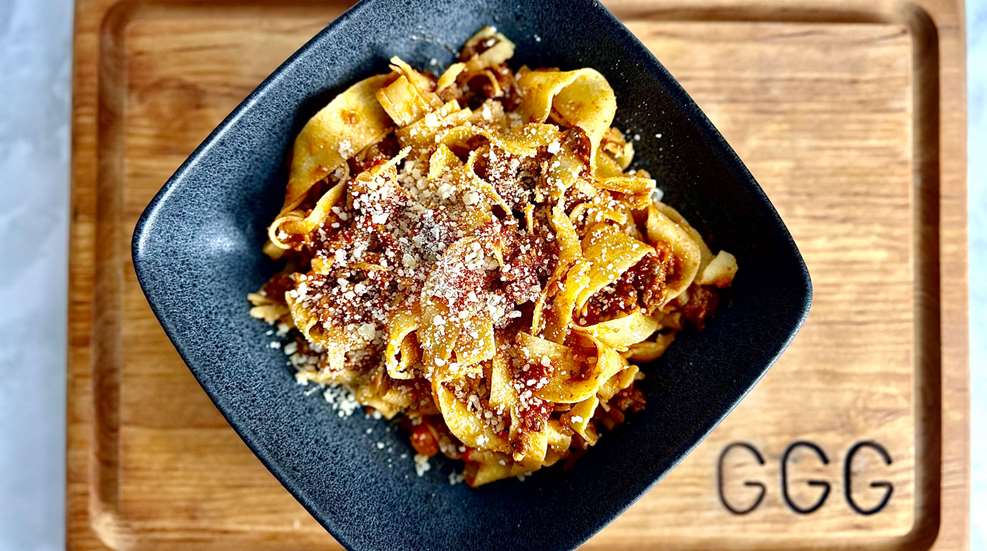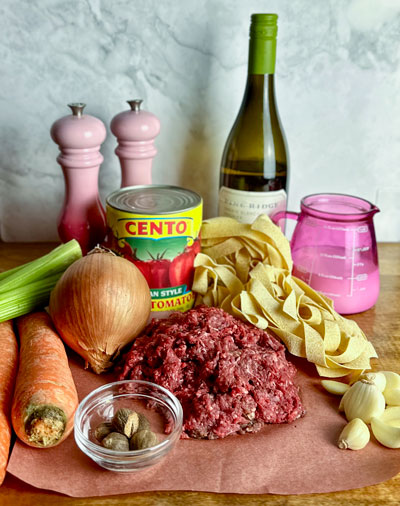
Growing up in Southeast Texas, wild hogs weren’t just a hunting opportunity, they were a problem. My dad’s farm had more than its fair share of feral pigs tearing up the land, and controlling their numbers became a regular part of life. Over the years, I became proficient in large-animal butchery, largely thanks to those wild hogs. One summer, I butchered 25 in just six weeks. It was a crash course in processing game efficiently, but more importantly, it provided me an opportunity to learn the value of turning an invasive species into incredible meals.
That brings me to this dish: wild pork Bolognese. I’ll admit, a slow-simmered, hearty meat sauce might not seem like an obvious choice for warmer weather. But trust me, there’s something about a rich, meaty pasta dish that speaks to the soul no matter the season. Whether you’re coming back from an early morning hog hunt, a long day on the water, a family hike or just looking for a satisfying meal to feed the crew, Bolognese is pure comfort in a bowl.
If you grew up with a classic red sauce ladled over spaghetti, you might be wondering: What’s the difference between a traditional meat sauce and Bolognese? While both are tomato-based, Bolognese originates from Bologna, Italy, and is more of a slow-cooked meat ragù than a straightforward marinara.

Unlike a typical American-style spaghetti sauce, which often features ground beef simmered in tomato sauce, Bolognese is richer and more layered in flavor. That might sound a little fancy—maybe even intimidating—but I promise it’s not. At its core, it’s just a slow-simmered meat sauce built with a few extra steps to deepen the flavor. It starts with finely diced onions, carrots and celery (soffritto), then gets a boost from wine, milk and sometimes pancetta. The result is a velvety, deeply flavorful sauce that clings beautifully to pasta—especially fresh tagliatelle or pappardelle.
And if you’re looking for a fun summertime activity with the family, this dish is perfect. Let the pork simmer away while you tackle homemade pasta from scratch—it’s a hands-on way to get everyone involved, and the payoff is well worth it.
Using wild pork instead of traditional beef or veal not only puts a hunter’s spin on this classic, it also gives the sauce a deeper, more complex flavor. Wild pork, especially from leaner cuts, benefits from the slow braise, breaking down into fork-tender perfection as it simmers. In my version, I keep it simple by using ground wild pork, cutting down on prep without sacrificing any of that rich, meaty goodness.
Wild hog hunting is an experience all its own. Unlike deer, hogs don’t come with a season—you can chase them year-round, and in Texas, you almost have to. Whether you’re spotting-and-stalking, hunting over feeders or running them with dogs, there’s no shortage of ways to get after pigs. Every hunt is a little different. The real work starts after the shot, though, and for me, that’s where the fun really began. My family used to throw pig parties—boucheries—where everyone gathered around to break down a hog, swapping stories, teaching each other butchery skills and, of course, cooking up a feast when the job was done.

So, while a big bowl of pasta might not be the first thing you think of for summer, to me, this dish carries the same spirit as those old boucheries—taking something wild, putting in the work and turning it into something worth sharing. And if that’s not the heart of hunting, I don’t know what is.
Wild Pork Bolognese Recipe

Ingredients:
- 1 lb. ground wild pork
- 1 small onion, finely diced
- 1 carrot, finely diced
- 3 celery stalks, finely diced
- 8 cloves garlic, minced
- 1 cup dry white wine
- 1 cup whole milk
- 1 can (28 ozs.) whole plum tomatoes
- Salt and black pepper, to taste
- ¼ cup butter
- 1 lb. tagliatelle, pappardelle or your pasta of choice
- Parmesan cheese, for serving
Instructions:
- Heat the butter in a large, heavy-bottomed pan over medium heat. Add the onion, carrot and celery, cooking until softened, about 5 minutes. Stir in the garlic and cook for another 30 seconds until fragrant.
- Add the ground wild pork. Cook, breaking it up with a spoon until browned and no longer pink, about 7-8 minutes. Season to taste with salt and black pepper.
- Slowly stir in the milk and let the sauce cook, stirring frequently, until the liquid has fully absorbed.
- Pour in the wine, scraping up any browned bits from the bottom of the pan. Let it simmer until all the liquid from the wine has cooked out.
- Stir in the can of tomatoes, crushing them slightly with a spoon. Reduce the heat to the lowest setting possible—you want just the gentlest simmer. Cook uncovered for at least 3 hours, stirring occasionally. As the sauce reduces, add ½ cup of water as needed to keep it from drying out.
- Bring a large pot of salted water to a boil and cook the pasta until al dente, usually 2 minutes less than the package instructions. Drain and toss with the Bolognese sauce.
- Plate the pasta, top with grated Parmesan, and enjoy with a glass of your favorite red wine or a cold beer.




































